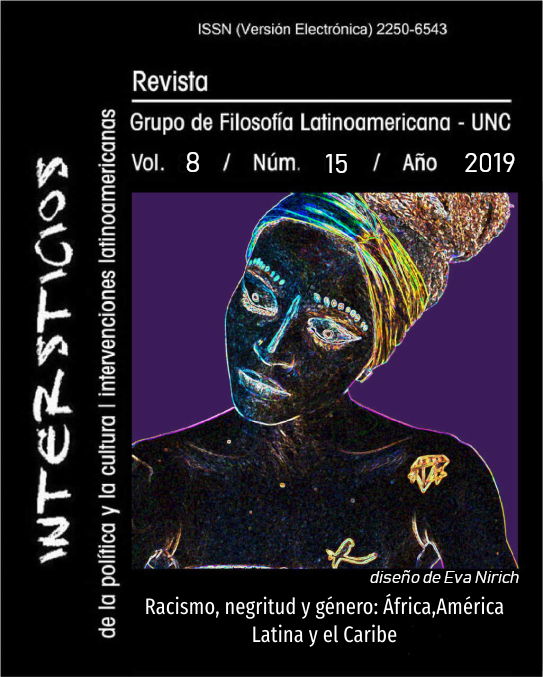The forgotten of the bicentennial: Feminism and Afro-American cultures behind a mural in Dolores
Keywords:
mural, feminism, afrodescendants, postcoloniality, heritageAbstract
Oblivion - the opposite mask or reverse of the plot of historical memory - is a form of protection and camouflage because postulating a statement as the only valid one obviates the possibility of the emergence of other possible ones. Nevertheless, from the interstices, subaltern statements emerge to question the universality of hegemony and offer alternatives that allow us to remember that the social construction of reality is a complex process, full of contradictory voices and, therefore, open to multiple possibilities of answers and senses capable of opening up numerous shortcuts to the possible.
The mural "Las olvidadas del bicentenario" painted on the wall of a school in Dolores, a Buenos Aires city located halfway between Buenos Aires and Mar del Plata, despite its meager dimensions - 1.30 m by 1.50 - in the first place, promotes questions about the absence of the afrodescendant woman in the celebrations for the Bicentennial of the foundation of that village in 2017 and, secondly, invites reflection on the naturalization of the oblivion of Afro-American cultures in the narration of local history.
It is conjectured that such omission is the result of intellectual laziness that prevents the guardians of local memory from asking themselves new questions about meaning. But, at the same time, this suppression is articulated with another of greater importance: an absolute ignorance about the existence of the International Decade of Afrodescendants, which under the theme "Afrodescendants: recognition, justice and development", began on 1 January 2015 and will end on 31 December 2024 established by the United Nations General Assembly on 30/12/2013.
Downloads
References
Andalzúa, G.(1981): Borderland. La Frontera. The new mestiza. Aunt Lute Books, San Francisco.
Bidaseca, K. (2015): Escritos en los cuerpos racializados. Lenguas, memoria y genealogías (pos)colonilaes del feminicidio. Edicions Universitat de les Illes Balears, España.
Elizalde, F. (1980). La heredad. Corregidor, Buenos Aires.
Korn, F. (1974). Los huéspedes del 20. Sudamericana, Buenos Aires.
Mascioli, A. (2002): ‘Caminos de acceso al usufructo y propiedad legal de la tierra en la frontera bonaerense. Dolores, 1798-1860”.
Revista Quinto Sol, No 6. Recuperado de: https://cerac.unlpam.edu.ar/index.php/quintosol/article/view/673
Meo Laos, V. G. (10/2013). La gestión de los espacios funerarios: El caso del cementerio de Dolores. Trabajo presentado en XIV Encuentro Iberoamericano de valoración y gestión de cementerios patrimoniales y 10a Reunión Nacional de la Red Mexicana de Estudio de Espacios y Cultura Funerarios, Ciudad de México.
Norá, P. ¨ La aventura de Les lieux de mémoire” en Revista Ayer No. 32. Dialnet, 1998. Recuperado de: https://introduccionalahistoriajvg.wordpress.com/2013/07/28/%E2%9C%8D-les-lieux-de-memoire-la-republique-la-nation-les-france-1984-1992/
Pirali, J. C. (2010). Dolores. Reseña de una ciudad con historia. Club Argentino de Servicios 2 de abril, Dolores.
Padula, A. A. y Meo Laos, V. G. (10/ 2012). Viejas y nuevas élites. Una aproximación a las tensiones sociales en el cementerio de Dolores. El valor pedagógico del espacio funerario. Trabajo presentado en V Jornadas Nacionales de Patrimonio Simbólico en Cementerios, Rosario, Argentina.
Padula, A. A. y Meo Laos, V. G. (10/ 2012). La lápida de Bertha Smith: un ejemplo de devoción popular. Trabajo presentado en V Jornadas Nacionales de Patrimonio Simbólico en Cementerios, Rosario, Argentina.
Quijano, A.. “Qué tal raza!”. Publicado en América Latina en Movimiento, No. 320: <http://alainet.org/publica/320.phtml>. Recuperado de: <http://alainet.org/active/929&lang=es>, el 22 de agosto de 2011.
Downloads
Additional Files
Published
Issue
Section
License
Authors who have publications with this journal agree to the following terms:
a. Authors will retain their copyright and grant the journal the right of first publication of their work, which will simultaneously be subject to the Creative Commons Attribution License that allows third parties to share the work as long as its author and first publication in this journal are indicated.
b. Authors may adopt other non-exclusive license agreements for distribution of the published version of the work (e.g., deposit it in an institutional telematic archive or publish it in a monographic volume) as long as the initial publication in this journal is indicated.
c. Authors are allowed and encouraged to disseminate their work through the Internet (e.g., in institutional telematic archives or on their web page) after the publication process, which may produce interesting exchanges and increase citations of the published work (see The effect of open access).


